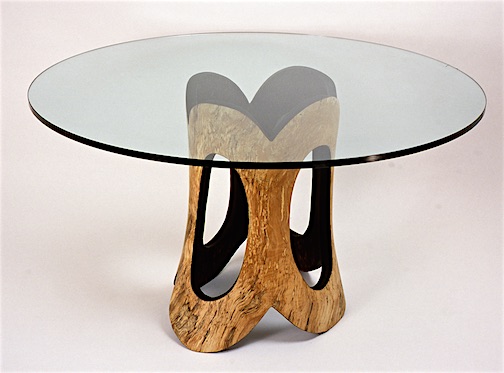1983
Hollows
In the late fall of 1982 a friend told me he had a cherry tree on his property that had to be taken down. He thought I might be interested in it. At 17 feet in circumference it was the largest cherry tree I’d ever seen around here. I was having ecstatic visions of single-board, cherry dining tables four feet wide and eight feet long, so yes, I was interested.
Woodshed full of hollow logs
The tree was well out of my league for harvesting so I contacted Michael, a tree surgeon friend from over in Bennington. He came by the next week. After examining the tree he fired up a chainsaw with an 18” bar, poked it into the tree’s base and walked around the tree as if undoing a zipper. It came down through the forest canopy like a brontosaurus tripping over a boulder.
I couldn’t believe my eyes. The tree was rotten hollow. The heartwood was deep red and punky. Center rot had left this specimen with a rim of living wood about eight to ten inches thick. Michael had known this from the outside of the tree. I had not and was devastated. My board-lust limp, I went home.
Double Dovetail
Such trees are dangerous to cut down because the logger can’t really know what’s going on inside it. The stresses and loads within center-rot trees ( hollows ) can cause them to behave in unpredictable ways when felling; “ widow-makers,” as every logger knows. Historically, hollows were used by loggers as culverts for logging roads in remote areas when they needed to cross a stream. That was before plastic culverts came to be.
Writing Chair
It took me a while to get over it, but by the spring of 1983 I had begun to think of the hollow cherry tree as a geometric cylinder rather than as boards. That lead me to think about how carved hollows might work as bases for tables and other furniture components. I’ve been working with hollows ever since; usually maple or yellow birch but occasionally cherry, red oak and beech.
Miller's Dining Table
My initial explorations were drum-type tables: a carved base with an inset piece of glass flush with the top such as Double Dovetail from 1983. Often I carve an integral hollow log section to create a base for a glass or wood topped table such as the Miller , Katzman and Margerita dining tables. I also began to cut the cylinders apart and to use the two ½ hollows as the basic units for modified trestle bases or as legs on tables and benches; Banchetto locale and the coffee table, La Frutta . To generate a tractor-style seat for Writing Chair I carved three-fourths of a cylinder which I joined to the yellow birch root system base with a chair swivel. The Counter Chairs were carved from a single spalted yellow birch hollow cut diagonally, upper left to lower right of the cylinder. The two halves share a common source.
Counter Chairs
Katzman Dining Table
In the Fall of 1984 I was at the Museum of African Art in NYC to see an exhibit of African furniture. There I saw Cameroonian tables and seating which were hollow-carved; the geometric cylinder being used as a basic furniture element as expressed by African makers. I saw work influenced directly from the raw material – the tree. It was exciting to learn that I had been working within an important tradition; at least in terms of approach to materials and process: material-based design. This has led to continued study of African and Oceanic carved work and further explorations with hollows. I was heartened to observe that, unaware, through my efforts to figure out how to make use of a center-rotten cherry tree in Marlboro VT, I had wandered into this vital, non-western furniture carving tradition.










